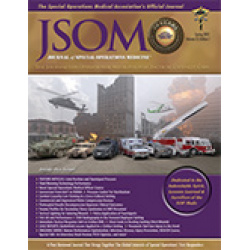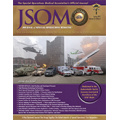Lessons Learned on the Battlefield Applied in a Civilian Setting
Cordier P, Benoit C, Belot-De Saint Leger F, Pauleau G, Goudard Y 21(1). 102 - 105 (Journal Article)
We report the case of a civilian 27-year-old man treated in a military hospital in France who sustained multiple stab wounds, including one in the left groin, with massive external bleeding. When first responders arrived, the patient was in hemorrhagic shock. A tourniquet and two intraosseous catheters were placed to start resuscitative care. On the patient's arrival at the hospital, bleeding was not controlled, so a junctional tourniquet was put in place and massive transfusion was started. Surgical exploration revealed a laceration of the superficial femoral artery and a disruption of the femoral vein. Vascular damage control was achieved by a general surgeon and consisted of primary repair of the superficial femoral artery injury and venous ligation. The patient was discharged from the intensive care unit after 2 days and from the hospital after 8 days. This case illustrates some of the persistent challenges shared between military and civilian trauma care. The external control of junctional hemorrhage is not easily achievable in the field, and junctional tourniquets have been therefore incorporated in the Tactical Combat Casualty Care guidelines. French lyophilized plasma was used for massive transfusion because it has been proven to be a logistically superior alternative to fresh-frozen plasma. Management of vascular wounds by nonspecialized surgeons is a complex situation that requires vascular damage-control skills; French military surgeons therefore follow a comprehensive structured surgical training course that prepares them to manage complex penetrating trauma in austere environments. Finally, in this case, lessons learned on the battlefield were applied to the benefit of the patient.


 Español
Español 




